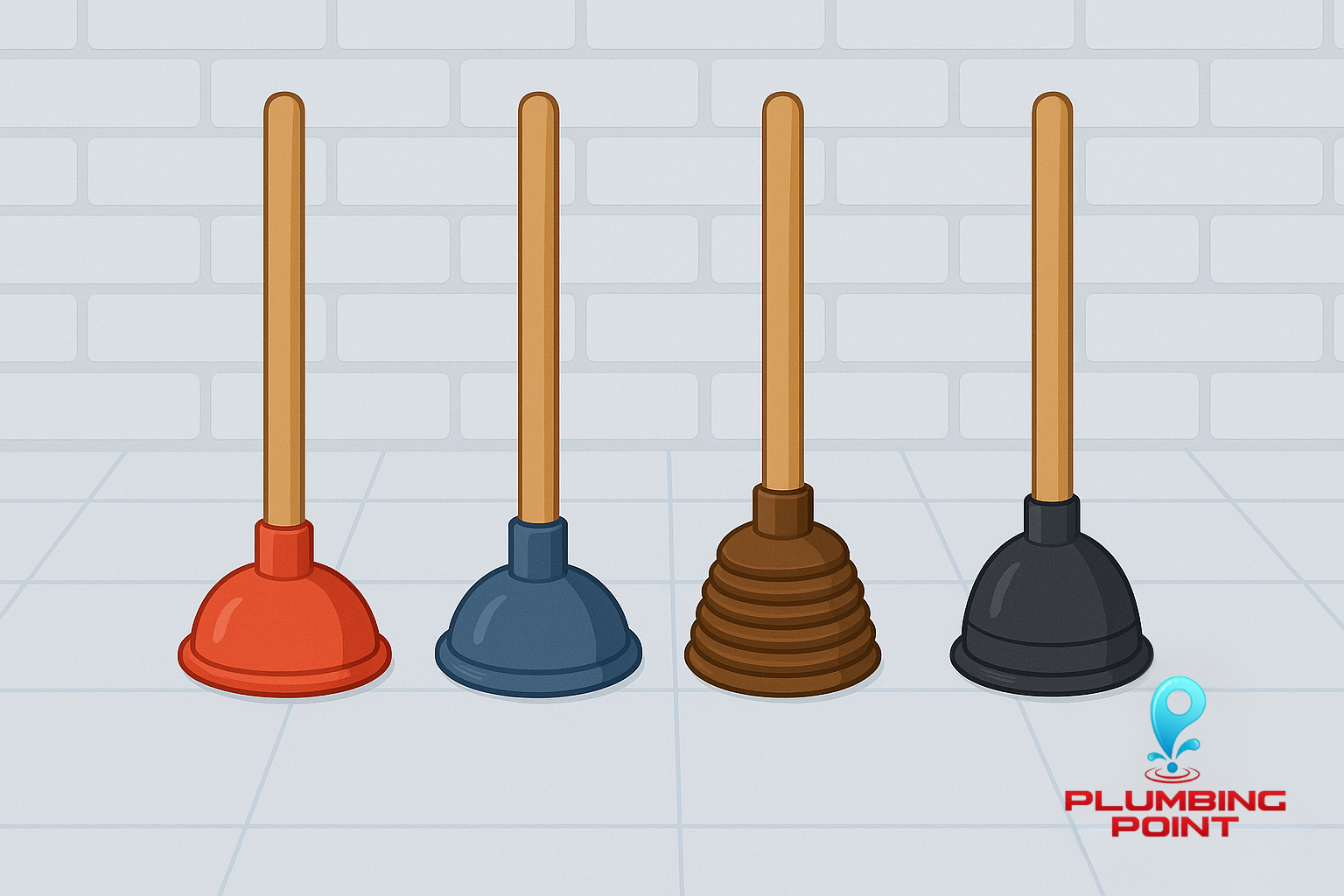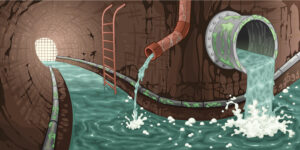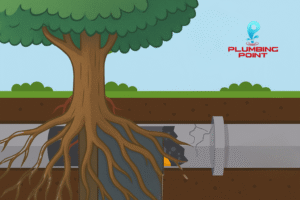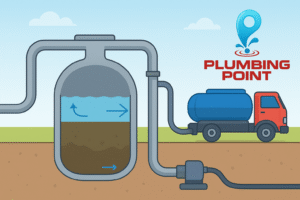|
Getting your Trinity Audio player ready...
|
From overflowing toilets to stubborn kitchen sink clogs, few household tools are as underrated yet essential as the humble plunger. However, not all plungers are created equal—and choosing the right plunger can mean the difference between a quick fix and a frustrating mess.
Whether you’re dealing with bathroom backups or kitchen mishaps, understanding the different plunger types is crucial.
Right Plunger: Understanding Its Importance
Let’s get one thing straight: grabbing any old plunger during a plumbing emergency can be a costly mistake. The right plunger isn’t just about size—it’s about shape, suction power, and suitability for the job. Using the wrong type can damage your plumbing or simply not work at all. So before we dive into the details, remember: one size doesn’t fit all in the world of plungers.
Basic Anatomy of a Plunger
Every plunger consists of two main components: the handle and the rubber suction cup (also called the flange). While this might seem straightforward, small differences in these parts can drastically change how effective a plunger is for specific jobs.
Handle Material Matters
Plunger handles are usually made of plastic, wood, or metal. Wooden handles offer sturdiness but can rot over time, while plastic handles are lighter and water-resistant. Metal handles, often with rubber grips, provide durability and ergonomic handling for heavy-duty use.
Cup or Flange Design
The cup design affects the plunger’s sealing ability. Flat cups are ideal for sinks, while flanged models are tailored for toilets. Some modern plungers even combine both features, offering versatility.
Types of Plungers: Sink vs. Toilet and Their Uses
Knowing the different plunger types is the first step in choosing the right plunger for your needs.
Do You Know This Cool Plunger Trick? (I had no Idea!)
In this video, we reveal the surprising differences between a toilet plunger and a sink plunger—something most people still get wrong! You’ll see which type is best for each kind of clog and why choosing the wrong one could actually make things worse. We also share a few clever tricks that make plunging easier, cleaner, and far more effective. If you’ve ever faced a stubborn clog, this is the must-watch guide you didn’t know you needed!
Sink Plunger (Flat-Cup Plunger)
This is the classic design with a simple rubber dome. Best for:
Kitchen sinks often clog due to food scraps, grease, and soap scum buildup. A flat-cup plunger is ideal here because it seals well on the sink’s flat surface. Regular plunging can prevent costly plumbing calls and keep your drain flowing smoothly.
Bathroom sinks commonly get blocked by hair, toothpaste, and cosmetic residues. The flat-bottom plunger fits perfectly over the small, even drain opening, allowing quick pressure application. It’s a fast and effective solution for shallow, recurring clogs.
Bathtubs and showers frequently clog due to hair and soap buildup in the drain trap. A flat-cup plunger works best since it can maintain strong suction against the tub’s smooth surface. It’s a great first response before using a snake or cleaner.
Its flat-bottomed cup forms a tight seal against flat surfaces, making it ineffective for toilets.
Flange Plunger (Toilet Plunger)
Equipped with an extended rubber flap (flange) that fits snugly into the toilet drain opening. Best for:
- Standard toilets
- Low-flow toilets
The flange creates a more focused suction and pressure burst, making it highly effective.
Accordion Plunger
Made from hard plastic and designed with an accordion-style mechanism. Best for:
- Toilets with stubborn clogs
- High-pressure plunging needs
It offers more force but can be difficult to use for beginners.
Taze Plunger
A specialty tool used mainly by professionals. This steel rod with a disc is inserted directly into the pipe to dislodge deep clogs. Best for:
- Commercial plumbing
- Large-diameter pipes
Rarely needed in typical households but effective in industrial scenarios.
How to Choose the Right Plunger
Now that you’re familiar with plunger types, let’s talk about selecting the right plunger based on your clogging crisis.
Match the Plunger to the Fixture
Toilet clog? A flange or accordion plunger is specially designed to fit the curved shape of a toilet drain. The extended rubber flap (flange) creates a strong seal and delivers focused pressure. These plungers are ideal for handling stubborn or deep toilet blockages.
Sink or tub clog? A flat-cup plunger is perfect for flat surfaces like sinks, bathtubs, or showers. Its wide, even base forms a snug seal over drains, allowing effective suction. Using this type prevents splashing and improves results on shallow clogs.
Consider the Frequency of Use
If you’re facing regular plumbing problems, invest in a dual-purpose plunger or own one of each type. Heavy-duty or accordion plungers are great for frequent issues.
Assess the Build Quality
Cheap plungers may seem appealing but often fail under pressure—literally. Choose durable materials, sturdy handles, and a strong cup design.
Space and Storage
Plungers can be bulky. Some fold or have smaller profiles for storage in tight spaces. If you live in an apartment or have limited bathroom space, a compact design is more practical.
Pro Tips for Using the Right Plunger
Even the right plunger won’t work if used incorrectly. Here are some pro tips:
- Create a good seal to ensure maximum pressure builds within the drain, allowing effective suction to loosen clogs. Without a tight seal, air escapes, making your effort much less effective. Press the cup firmly over the drain to form a secure connection.
- Use enough water to submerge the plunger’s rubber cup completely, as water creates the needed force—not air. Plunging in dry conditions only pushes air around, doing little to dislodge the blockage. Add water to the bowl or basin if necessary before plunging.
- Plunge vigorously with quick, strong movements that create hydraulic pressure to shift the clog. Avoid weak or slow plunges, as they won’t generate enough force. A firm rhythm of pushes and pulls usually gets the best results.
- Sanitize after use to eliminate germs, waste residue, and odors that linger on the rubber cup. A rinse with hot water followed by a disinfectant or bleach solution helps maintain cleanliness. This habit also protects your household from unwanted bacteria.
Common Mistakes When Choosing a Plunger
Many people fail to resolve clogs because they fall for these common mistakes:
- Using a sink plunger in a toilet: It doesn’t create the right seal and is ineffective.
- Not cleaning the plunger after use: This can lead to unsanitary storage conditions.
- Buying based solely on price: Cheap plungers usually lead to poor results.
What to Avoid When Buying a Plunger
Avoid plungers that:
Feel flimsy or too soft plungers lack the rigidity needed to create strong suction, making them inefficient during use. They often collapse under pressure, especially when tackling tough clogs. A sturdy, firm cup ensures better force and performance.
Don’t fit comfortably in your hand can lead to slipping, poor control, and even hand fatigue during plunging. Ergonomic handles make a significant difference, especially when force is required. Always test the grip and weight before buying.
Lack clear design for specific fixtures means the plunger may not seal properly, reducing its effectiveness. A mismatched plunger for a toilet or sink can actually worsen the clog or cause splashing. Each fixture requires a tailored plunger shape.
Come without a proper drip tray or holder can be unsanitary and messy to store. After use, plungers retain water and waste, which needs containment. A drip tray not only keeps your bathroom clean but also prolongs the tool’s hygiene.
How to Maintain Your Plunger
To get the most from your right plunger, follow these care tips:
Store it in a dry place with good ventilation to prevent mold, mildew, or unpleasant odors from forming on the rubber. Damp environments can cause the rubber to degrade faster. A well-ventilated area ensures the plunger stays sanitary and lasts longer.
Clean it with bleach or disinfectant after every use to eliminate bacteria, viruses, and any lingering odors from waste materials. This not only ensures hygiene but also prevents the spread of germs in your bathroom. Regular cleaning keeps the plunger ready for safe reuse.
Replace it if the rubber cup becomes brittle or torn since a damaged plunger won’t form a proper seal, rendering it ineffective. Cracked rubber can also cause leaks during plunging, making cleanup messier. A functional plunger is crucial for efficient clog removal.
Alternative Tools to Plungers
Sometimes, a plunger isn’t enough. If you’re still stuck, consider:
Drain snakes are flexible, coiled tools designed to reach deep into drains and physically dislodge stubborn blockages. They work well where plungers fall short, especially for clogs further down the pipe. Ideal for hair, grease, or debris build-up, they offer a hands-on, effective solution.
Chemical drain cleaners are fast-acting liquids or gels that dissolve organic materials causing clogs. While convenient, they should be used cautiously, as overuse can corrode pipes and damage plumbing systems. They are best reserved for occasional use when mechanical methods fail.
Wet/dry vacuums can be used creatively to clear clogs by either sucking the blockage out or pushing it further with pressure. Their power makes them useful for severe clogs that resist plunging or snaking. Always seal tightly around the drain to ensure effectiveness.
Professional plumbers are the go-to experts when home methods fail or when you’re dealing with persistent or serious plumbing issues. Their advanced tools and experience help diagnose and resolve problems quickly and safely. Though pricier, they often save time and prevent further damage.
Choosing the Right Plunger for Emergency Kits
Every household emergency kit should include a right plunger. Opt for a dual-flange plunger with a holder for cleanliness and readiness. Store it in an accessible location like the bathroom or laundry room.
FAQs
What is the best type of plunger for toilets?
A flange or accordion plunger works best for toilets. These provide strong suction and are shaped to fit the toilet drain perfectly.
Can I use the same plunger for sink and toilet?
Technically yes, but it’s not hygienic or effective. Use a separate flat-cup plunger for sinks and a flange for toilets.
How often should I replace my plunger?
Replace it if the rubber becomes cracked, stiff, or if it no longer forms a proper seal. Typically, a good-quality plunger lasts 2–3 years.
Why won’t my plunger unclog the toilet?
You might be using the wrong type or not enough water. Try an accordion plunger or add water to cover the cup completely.
Do plungers work on all clogs?
No. If the clog is deep or caused by a foreign object, you may need a drain snake or plumber assistance.
What’s the most versatile plunger?
A combo flange plunger that works on both flat and curved surfaces is the most versatile for household use.




